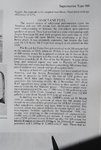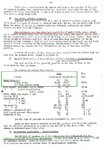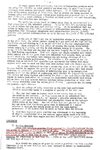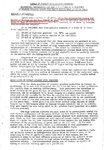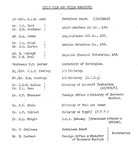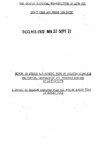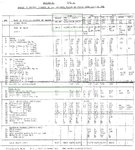Kurfürst
Staff Sergeant
Some more evidence:
This is from a researcher (Pips over Allaboutwarafe discussion boards, who posted this some time ago), researching another subject (Dutch East Indies Fuel levels prior to the Japanese Invasion) at the Australian War Memorial Archives, from a document, copied to the Australian Military Commission in England in February 1941, by Roll Royce to Lord Beaverbrook outlining past, current and proposed changes to the Merlin; and factors that affect it's performance. It was a collection of lose-leaf typed pages, included as an addendum in a report titled Fuel Supplies to The British Empire And It's Commonwealth; Outlook, Ramifications and Projections For The Prosecution Of The War.
The reason why it is included amongst AWM papers is because the Australian Government at that time was protesting vigoriously about the continued supply of lower grade 87 octane fuel when it too wanted 100 octane for the RAAF. McFarland, Pugh, Hart, Perret, Lumsden and even Churchill have all quoted parts from the report.
"The first bulk shipment of 100 octane fuel had arrived in Britain in June 1939 from the Esso refinery in Aruba. This and subsequent tanker shipments from Aruba, Curacao and the USA were stockpiled while the RAF continued to operate on 87 octane petrol. Having secured what were considered reasonably sufficient quantities of 100 octane, Fighter Command began converting its engines to this standard in March 1940, allowing boost (manifold) pressures to be raised without the risk of detonation in the cylinders. This initial increase in maximum boost from 6 lb to 9 lb delivered a useful power growth of around 130hp at the rated altitude.
By the time of the invasion of the Low Countries by Germany in May 1940 the RAF had converted approximately 25 % of it's total fighter force to 100 octane fuel use. The subsequent escalation in air activity and demands placed upon Fighter Command over the next two months put great strain on both the 100 octane fuel stockpiles and aircraft modified to use the fuel. Against the backdrop of total war the RAF found that it's reserves of 100 octane fuel was well below the level considered necessary for widespread use, for any sustained length of time.
Two actions were immediately undertaken by the British War Cabinet in May to resolve the looming crisis. Firstly 87 octane fuel was deemed the primary fuel source to be used until further supplies could be discovered and delivered in sufficient quantities to allow the Merlin conversions to again take place. Those existing fighters already so converted (approximately 125) would continue to use what supplies of 100 octane were available, but all other fighters that had not been modified to continue with the use of 87 octane (of which there was more than adequate supply). The second action was for the British Government to contract the Shell Oil Refining Company to assist the British-controlled Iraqi Petroleum Company at Kirkuk to produce 100 octane fuel. This arrangement proved quite successful as production was quickly converted to 100 octane fuel.
The first Middle East shipment of 100 octane fuel arrived in Portsmouth on 12th August, with a further two deliveries in September and four in October. Although too late to allow widespread conversion for the use of the fuel the deliveries did ensure that from this point on Britain would not be lacking in 100 octane fuel levels. With the newfound supply RAF Fighter Command again embarked upon a Merlin II and III conversion to 100 octane use from late September, finally achieving 100% conversion of it's fighter force by the end of November in 1940.
The second description is from Gavin Bailey's work, "The Narrow Margin of Criticality: The Question of the Supply of 100-Octane Fuel in the Battle of Britain", originally published online on April 15, 2008:
Significantly, at the same time as the British were preparing to take these preliminary steps required to utilise 100-octane fuel, a committee was formed consisting of representatives from the leading oil companies, Imperial Chemical Industries and Air Ministry officers. Chaired by Sir Harold Hartley, the chairman of the Fuel Research Board, the objective of the committee was to recommend measures to ensure that adequate supplies of 100-octane fuel could be supplied in wartime. The immediate impetus behind this development was the possibility that the main existing source of supply""hydrogenation plants run by Standard Oil and Shell within the United States""might become inaccessible owing to the embargo requirements of the US Neutrality Acts on the outbreak of war. A further consideration was the fact that 100-octane supplies were purchased in dollars in the case of Shell and Standard Oil production in the United States and in Dutch guilders for Shell production from Curacao in the Netherlands West Indies and later on from the Netherlands East Indies. This presented a potential problem for British balance of payments and foreign currency exchange which was only resolved in the short- and medium-term future by the adoption of supply under the terms of lend–lease in 1941.
The Hartley Committee eventually determined in December 1938 that three new hydrogenation plants should be funded partially at government expense in Trinidad and in Britain to expand British-controlled annual 100-octane fuel production capacity to 720,000 tons above the level already in prospect from existing supplies. At this point Shell and ICI had co-operated to build the first hydrogenation plant in Britain at Billingham on Teeside and further plants were being planned at Stanlow in Cheshire by Shell and Heysham and Thornton in Lancashire by the Air Ministry. In January 1939, when the Hartley Committee report was adopted by the Committee of Imperial Defence, the Treasury was able to cancel one of the planned plants in Trinidad on the grounds of cost, in return for an expansion of the authorised war reserve from 410,000 tons to 800,000 tons, 700,000 tons of which were to consist of 100-octane. This represented an entire years worth of estimated consumption on the basis of the major expansion and production schemes then in force and required an enormous investment in building the required protected underground storage infrastructure.
RAF tests with 100-octane had begun in 1937, but clearance for operational use was withheld as stocks were built up. In March 1939, the Air Ministry decided to introduce 100-octane fuel into use with sixteen fighter and two twin-engined bomber squadrons by September 1940, when it was believed that the requirement to complete the war reserve stock would have been met, with the conversion of squadrons beginning at the end of 1939.34
By the time war broke out, the available stocks of aviation fuel had risen to 153,000 tons of 100-octane and 323,000 tons of other grades (mostly 87-octane).35 The actual authorisation to change over to 100-octane came at the end of February 1940 and was made on the basis of the existing reserve and the estimated continuing rate of importation in the rest of the year The available stock of 100-octane fuel at this point was about 220,000 tons. Actual use of the fuel began after 18 May 1940, when the fighter stations selected for the changeover had completed their deliveries of 100-octane and had consumed their existing stocks of 87-octane. While this was immediately before the intensive air combat associated with the Dunkirk evacuation, where Fighter Command units first directly engaged the Luftwaffe, this can only be regarded as a fortunate coincidence which was contingent upon much earlier decisions to establish, store and distribute sufficient supplies of 100-octane fuel.
This is from a researcher (Pips over Allaboutwarafe discussion boards, who posted this some time ago), researching another subject (Dutch East Indies Fuel levels prior to the Japanese Invasion) at the Australian War Memorial Archives, from a document, copied to the Australian Military Commission in England in February 1941, by Roll Royce to Lord Beaverbrook outlining past, current and proposed changes to the Merlin; and factors that affect it's performance. It was a collection of lose-leaf typed pages, included as an addendum in a report titled Fuel Supplies to The British Empire And It's Commonwealth; Outlook, Ramifications and Projections For The Prosecution Of The War.
The reason why it is included amongst AWM papers is because the Australian Government at that time was protesting vigoriously about the continued supply of lower grade 87 octane fuel when it too wanted 100 octane for the RAAF. McFarland, Pugh, Hart, Perret, Lumsden and even Churchill have all quoted parts from the report.
"The first bulk shipment of 100 octane fuel had arrived in Britain in June 1939 from the Esso refinery in Aruba. This and subsequent tanker shipments from Aruba, Curacao and the USA were stockpiled while the RAF continued to operate on 87 octane petrol. Having secured what were considered reasonably sufficient quantities of 100 octane, Fighter Command began converting its engines to this standard in March 1940, allowing boost (manifold) pressures to be raised without the risk of detonation in the cylinders. This initial increase in maximum boost from 6 lb to 9 lb delivered a useful power growth of around 130hp at the rated altitude.
By the time of the invasion of the Low Countries by Germany in May 1940 the RAF had converted approximately 25 % of it's total fighter force to 100 octane fuel use. The subsequent escalation in air activity and demands placed upon Fighter Command over the next two months put great strain on both the 100 octane fuel stockpiles and aircraft modified to use the fuel. Against the backdrop of total war the RAF found that it's reserves of 100 octane fuel was well below the level considered necessary for widespread use, for any sustained length of time.
Two actions were immediately undertaken by the British War Cabinet in May to resolve the looming crisis. Firstly 87 octane fuel was deemed the primary fuel source to be used until further supplies could be discovered and delivered in sufficient quantities to allow the Merlin conversions to again take place. Those existing fighters already so converted (approximately 125) would continue to use what supplies of 100 octane were available, but all other fighters that had not been modified to continue with the use of 87 octane (of which there was more than adequate supply). The second action was for the British Government to contract the Shell Oil Refining Company to assist the British-controlled Iraqi Petroleum Company at Kirkuk to produce 100 octane fuel. This arrangement proved quite successful as production was quickly converted to 100 octane fuel.
The first Middle East shipment of 100 octane fuel arrived in Portsmouth on 12th August, with a further two deliveries in September and four in October. Although too late to allow widespread conversion for the use of the fuel the deliveries did ensure that from this point on Britain would not be lacking in 100 octane fuel levels. With the newfound supply RAF Fighter Command again embarked upon a Merlin II and III conversion to 100 octane use from late September, finally achieving 100% conversion of it's fighter force by the end of November in 1940.
The second description is from Gavin Bailey's work, "The Narrow Margin of Criticality: The Question of the Supply of 100-Octane Fuel in the Battle of Britain", originally published online on April 15, 2008:
Significantly, at the same time as the British were preparing to take these preliminary steps required to utilise 100-octane fuel, a committee was formed consisting of representatives from the leading oil companies, Imperial Chemical Industries and Air Ministry officers. Chaired by Sir Harold Hartley, the chairman of the Fuel Research Board, the objective of the committee was to recommend measures to ensure that adequate supplies of 100-octane fuel could be supplied in wartime. The immediate impetus behind this development was the possibility that the main existing source of supply""hydrogenation plants run by Standard Oil and Shell within the United States""might become inaccessible owing to the embargo requirements of the US Neutrality Acts on the outbreak of war. A further consideration was the fact that 100-octane supplies were purchased in dollars in the case of Shell and Standard Oil production in the United States and in Dutch guilders for Shell production from Curacao in the Netherlands West Indies and later on from the Netherlands East Indies. This presented a potential problem for British balance of payments and foreign currency exchange which was only resolved in the short- and medium-term future by the adoption of supply under the terms of lend–lease in 1941.
The Hartley Committee eventually determined in December 1938 that three new hydrogenation plants should be funded partially at government expense in Trinidad and in Britain to expand British-controlled annual 100-octane fuel production capacity to 720,000 tons above the level already in prospect from existing supplies. At this point Shell and ICI had co-operated to build the first hydrogenation plant in Britain at Billingham on Teeside and further plants were being planned at Stanlow in Cheshire by Shell and Heysham and Thornton in Lancashire by the Air Ministry. In January 1939, when the Hartley Committee report was adopted by the Committee of Imperial Defence, the Treasury was able to cancel one of the planned plants in Trinidad on the grounds of cost, in return for an expansion of the authorised war reserve from 410,000 tons to 800,000 tons, 700,000 tons of which were to consist of 100-octane. This represented an entire years worth of estimated consumption on the basis of the major expansion and production schemes then in force and required an enormous investment in building the required protected underground storage infrastructure.
RAF tests with 100-octane had begun in 1937, but clearance for operational use was withheld as stocks were built up. In March 1939, the Air Ministry decided to introduce 100-octane fuel into use with sixteen fighter and two twin-engined bomber squadrons by September 1940, when it was believed that the requirement to complete the war reserve stock would have been met, with the conversion of squadrons beginning at the end of 1939.34
By the time war broke out, the available stocks of aviation fuel had risen to 153,000 tons of 100-octane and 323,000 tons of other grades (mostly 87-octane).35 The actual authorisation to change over to 100-octane came at the end of February 1940 and was made on the basis of the existing reserve and the estimated continuing rate of importation in the rest of the year The available stock of 100-octane fuel at this point was about 220,000 tons. Actual use of the fuel began after 18 May 1940, when the fighter stations selected for the changeover had completed their deliveries of 100-octane and had consumed their existing stocks of 87-octane. While this was immediately before the intensive air combat associated with the Dunkirk evacuation, where Fighter Command units first directly engaged the Luftwaffe, this can only be regarded as a fortunate coincidence which was contingent upon much earlier decisions to establish, store and distribute sufficient supplies of 100-octane fuel.


